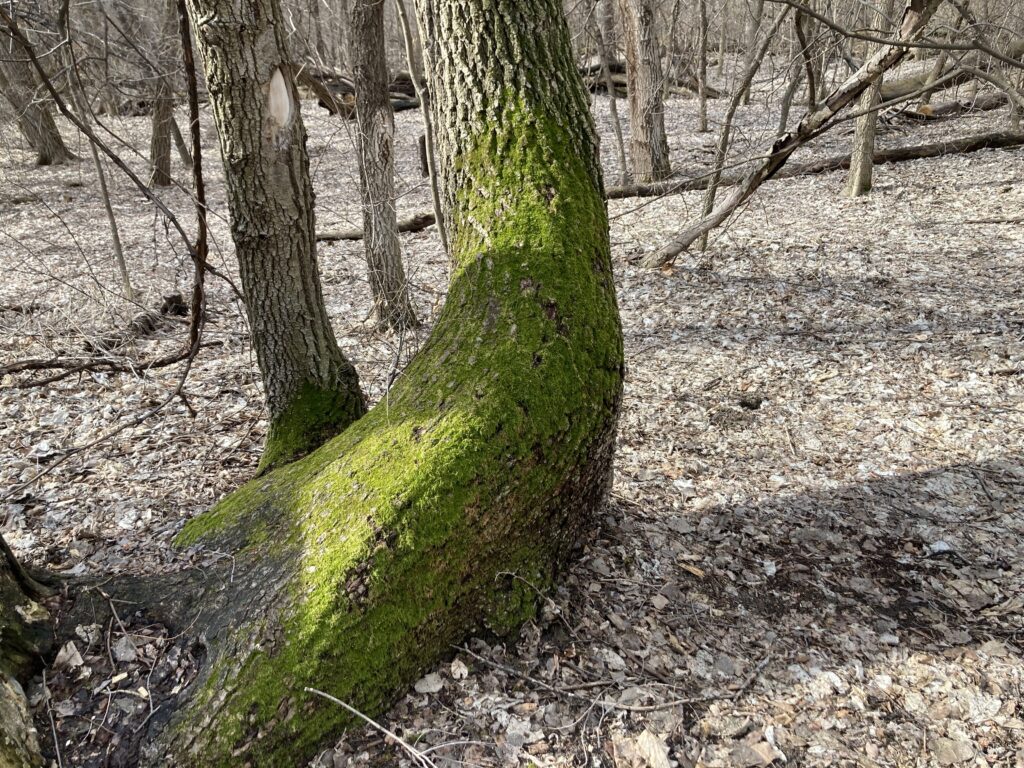55 minutes
ravine / longfellow flats / 7 oaks
34 degrees
Took Delia for a walk this morning. With the sun and the birds and the dry ground, it felt warmer than 34. Spring! What a wonderful morning! Walked down the wood steps to the winchell trail just above the ravine. Heard the steady, soothing drip of water falling out of the sewer pipe and onto the scattered rocks — riprap — then over the limestone ledge to the exposed pipe on the forest floor. No more ice or slick spots. The soft light made all the brown and rusted orange glow. I studied the husk of a tree on the edge of the gravel trail — still upright, but not much of a trunk left, and no leaves, one or two rotted branches. Climbed out and over to the Drs. Dorothy and Irving Bernstein Scenic Rest Area Overlook to check out the view. Then went down the steps to the abandoned dirt and leaf-littered trail that hugs the edge. Part of this trail only has the posts for a chainlink fence, part of it has the whole fence half-buried. Walked through the tunnel of trees, then down the old stone steps to Longfellow Flats. Walked past a huge tree on the ground, moved off to the side of the trail by park workers. The trunk was stripped clean and bare at the top, and thick with bark at the bottom — a very noticeable contrast in girth and texture. The river was beautiful and blue up close, all silvery sparkle from a distance. Powered back up the steps, which felt good on my glutes and calves, crossed the river road and made our way past 7 oaks to home.
Steps Taken
- worn wooden steps at the edge of the 36th street parking lot
- the makeshift steps closer to the ravine made from slabs of rock sticking out of the dirt
- limestone steps at the Drs. Bernstein Overlook
- the old stone steps to longfellow flats — 112 steps
10 Things
- silvery river burning through a break in the trees
- drip drip drip — water falling into the ravine
- bright blue graffiti on a wall only seen when you’re deep in the ravine
- the abandoned posts of a chainlink fence above the gorge
- the way the thinned-out trees, the soft sand, and the small curve of the path frames the water and the air — wide open, vast, yet contained enough to take in all at once
- at least 2 woodpeckers softly knocking on rotting wood, later one of the woodpeckers laughing
- the st. thomas bells
- voices behind, then two walkers passing past us
- on the forest floor, looking up at the top of the bluff, watching as runners glided by, looking so high and small
- in the floodplain forest, not too far from where the trees open to the river, a tree covered with bright green moss

orange
During the walk, I thought about orange, especially in terms of the history of the color that I had just read yesterday. The fruit came before the name of the color. It wasn’t that the color didn’t exist until it was given a name, it’s just that people didn’t recognize it as orange. It was yellow-red or brown. I also thought about what I had read about Van Gogh and his still life painting with oranges, how his focus was not the fruit, but the color. The color as its own thing. I pulled out my phone, and spoke this idea into it:
Orange existed before it was attached to a word, before it was attached to an object.